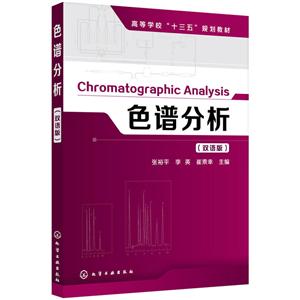预估到手价是按参与促销活动、以最优惠的购买方案计算出的价格(不含优惠券部分),仅供参考,未必等同于实际到手价。
-
>
宇宙、量子和人类心灵
-
>
(精)BBC地球故事系列-星际旅行
-
>
从一到无穷大
-
>
图说相对论(32开平装)
-
>
一本有趣又有料的化学书
-
>
刘薰宇的数学三书:原来数学可以这样学全3册
-
>
光学零件制造工艺学
色谱分析(双语版)/张裕平 版权信息
- ISBN:9787122317414
- 条形码:9787122317414 ; 978-7-122-31741-4
- 装帧:一般胶版纸
- 册数:暂无
- 重量:暂无
- 所属分类:>
色谱分析(双语版)/张裕平 本书特色
《色谱分析》(双语版)共分八章,系统介绍了色谱分析的基本理论、薄层色谱、气相色谱、高效液相色谱、离子色谱、尺寸排阻色谱、毛细管电泳和电色谱以及色谱技术中样品前处理技术等内容。本书集理论性与实践性为一体,在材料选择上注重知识的基础性和系统性,同时兼顾色谱技术的*进展。《色谱分析》(双语版)可供化学类专业高年级本科生和研究生使用,以提高专业英语水平,为后续的科研工作做好准备;本书也可供科研工作者参考。
色谱分析(双语版)/张裕平 内容简介
《色谱分析》(双语版)共分八章,系统介绍了色谱分析的基本理论、薄层色谱、气相色谱、高效液相色谱、离子色谱、尺寸排阻色谱、毛细管电泳和电色谱以及色谱技术中样品前处理技术等内容。本书集理论性与实践性为一体,在材料选择上注重知识的基础性和系统性,同时兼顾色谱技术的很新进展。 《色谱分析》(双语版)可供化学类专业高年级本科生和研究生使用,以提高专业英语水平,为后续的科研工作做好准备;本书也可供科研工作者参考。
色谱分析(双语版)/张裕平 目录
1.1General concepts of analytical chromatography3
1.2The chromatogram5
1.3Gaussian-shaped elution peaks7
1.4The plate theory8
1.5Nernst partition coefficient (K)11
1.6Column efficiency12
1.6.1Theoretical efficiency (number of theoretical plates)12
1.6.2Effective plates number (real efficiency)13
1.6.3Height equivalent to a theoretical plate (HETP)13
1.7Retention parameters14
1.7.1Retention times14
1.7.2Retention volume (or elution volume)14
1.7.3Hold-up volume (or dead volume)14
1.7.4Retention (or capacity)factor15
1.8Separation (or selectivity) factor between two solutes16
1.9Resolution factor between two peaks17
1.10The rate theory of chromatography18
1.10.1Van Deemter’s equation18
1.10.2Golay’s equation20
1.11Optimization of a chromatographic analysis21
1.12Classification of chromatographic techniques23
1.12.1Liquid phase chromatography (LC)23
1.12.2Gas phase chromatography (GC)24
1.12.3Supercritical fluid chromatography (SFC)25
Problems25
第1章 色谱法的发明 27
1.1分析色谱的一般概念28
1.2色谱图29
1.3洗脱峰的高斯谱形29
1.4塔板理论29
1.5能斯特分配系数(K)30
1.6柱效31
1.6.1理论效率(理论塔板数)31
1.6.2有效塔板数(真实效率)32
1.6.3理论塔板高度32
1.7保留参数32
1.7.1保留时间32
1.7.2保留体积(或洗脱体积)33
1.7.3死体积33
1.7.4保留因子(或容量因子)33
1.8分离因子(选择性因子)34
1.9分辨率34
1.10色谱法的速率理论34
1.10.1范第姆特方程35
1.10.2Golay方程36
1.11色谱分析法的优化36
1.12色谱技术的分类37
1.12.1液相色谱(LC)37
1.12.2气相色谱(GC)37
1.12.3超临界流体色谱(SFC)38
Chapter 2 Thin Layer Chromatography 39
2.1Principle of TLC39
2.1.1Deposition of the sample39
2.1.2Developing the plate40
2.1.3Identifying the spots41
2.2Characteristics of TLC42
2.3Stationary phases43
2.4Separation and retention parameters44
2.5Quantitative TLC45
Problems47
第2章 薄层色谱法 48
2.1TLC的原理48
2.1.1点样48
2.1.2薄层板的显影48
2.1.3斑点的识别49
2.2TLC的特性49
2.3固定相49
2.4分离和保留参数50
2.5TLC的定量分析50
Chapter 3 Gas Chromatography 52
3.1Instruments for gas-liquid chromatography53
3.1.1Carrier gas system53
3.1.2Sample injection system55
3.1.3Column configurations and column ovens57
3.1.4Chromatographic detectors57
3.2GC instrument component design59
3.2.1Thermal conductivity detector (TCD)61
3.2.2Flame ionization detector (FID)63
3.2.3Electron capture detector (ECD)64
3.2.4Sulfur-phosphorous flame photometric detector (SP-FPD)67
3.2.5Nitrogen-phosphorous detector (NPD)68
3.3Gas chromatography-mass spectrometry (GC-MS)69
3.3.1Gas chromatography-mass spectrometry73
3.3.2Interface76
3.3.3Recording and analysis77
3.3.4Resolution78
3.4Selection of a stationary phase79
3.4.1Sample classification79
3.4.2Suitable stationary phases80
3.5The scope of GC analysis82
3.6Limitations of GC83
Problems83
第3章 气相色谱法 85
3.1气-液色谱仪器85
3.1.1载气系统85
3.1.2进样系统86
3.1.3色谱柱参数和柱温箱86
3.1.4色谱检测器87
3.2气相色谱检测器部件的设计87
3.2.1热导检测器(TCD)88
3.2.2火焰离子化检测器(FID )89
3.2.3电子捕获检测器(ECD)90
3.2.4硫-磷火焰光度检测器(SP-FPD)91
3.2.5氮磷检测器(NPD)91
3.3气相色谱-质谱法(GC-MS)92
3.3.1气相色谱-质谱法94
3.3.2接口95
3.3.3记录和分析95
3.3.4分辨率95
3.4固定相的选择96
3.4.1样品分类96
3.4.2选择合适的固定相97
3.5气相色谱分析的范围98
3.6气相色谱法的局限性98
Chapter 4 High-Performance Liquid Chromatography 99
4.1Instrumentation102
4.1.1Mobile phase reservoir and solvent treatment system102
4.1.2Pumping system104
4.1.3Sample injection system105
4.1.4Columns for HPLC105
4.1.5HPLC detector114
4.1.6LC/MS and LC/MS/MS120
4.2Partition chromatography122
4.2.1Bonded-phase packings122
4.2.2Normal and reversed-phase packings122
4.2.3Choice of mobile and stationary phases124
4.2.4Applications125
4.3Ion chromatography126
4.3.1Ion chromatography based on suppressors127
4.3.2Single-column ion chromatography129
4.4Size-exclusion chromatography129
4.4.1Column packing130
4.4.2Applications130
4.5Affinity chromatography131
4.6Chiral chromatography132
Problems133
第4章 高效液相色谱法 135
4.1仪器135
4.1.1流动相储液瓶和溶剂处理系统136
4.1.2泵系统136
4.1.3进样系统136
4.1.4HPLC柱子137
4.1.5HPLC检测器141
4.1.6LC/MS和LC/MS/MS142
4.2分配色谱143
4.2.1键合相填料143
4.2.2正相和反相填料143
4.2.3流动相和固定相的选择144
4.2.4应用144
4.3离子色谱法145
4.3.1基于抑制柱的离子色谱145
4.3.2单柱离子色谱145
4.4体积排阻色谱146
4.4.1柱填料146
4.4.2应用146
4.5亲和色谱147
4.6手性色谱147
Chapter 5 Ion Chromatography 148
5.1Basics of ion chromatography148
5.2Stationary phases151
5.2.1Polymer-based materials151
5.2.2Silica-based materials152
5.2.3Resin films153
5.3Mobile phases153
5.4Conductivity detectors155
5.5Ion suppressors156
5.6Quantitative analysis by chromatography158
5.6.1Principle and basic relationship159
5.6.2Areas of the peaks and data treatment software159
5.6.3External standard method160
5.6.4Internal standard method162
5.6.5Internal normalization method164
Problems165
第5章 离子色谱法 169
5.1离子色谱法基础169
5.2固定相170
5.2.1聚合物基材料170
5.2.2硅胶基质材料171
5.2.3树脂膜171
5.3流动相171
5.4电导检测器171
5.5离子抑制器172
5.6色谱定量分析173
5.6.1原理与基本关系173
5.6.2峰面积与数据处理软件173
5.6.3外标法174
5.6.4内标法174
5.6.5内标归一化法176
Chapter 6 Size Exclusion Chromatography 177
6.1Principle of SEC177
6.2Stationary and mobile phases179
6.3Calibration curves180
6.4Instrumentation181
6.5Applications of SEC182
6.5.1Molecular weight distribution analysis183
6.5.2Other analysis183
Problems184
第6章 尺寸排阻色谱法 186
6.1SEC的原理186
6.2固定相和流动相187
6.3校正曲线187
6.4仪器188
6.5SEC的应用188
6.5.1分子量分布分析188
6.5.2其他分析188
Chapter 7 Capillary Electrophoresis and Electrochromatography 189
7.1From zone electrophoresis to capillary electrophoresis189
7.2Electrophoretic mobility and electro-osmotic flow191
7.2.1Electrophoretic mobility-electromigration193
7.2.2Electro-osmotic mobility-electro-osmotic flow193
7.2.3Apparent mobility195
7.3Instrumentation196
7.4Electrophoretic techniques197
7.4.1Capillary zone electrophoresis (CZE)197
7.4.2Micellar electrokinetic capillary chromatography (MEKC)198
7.4.3Capillary gel electrophoresis (CGE)198
7.4.4Capillary isoelectric focusing (CIEF)199
7.5Performance of CE200
7.6Capillary electrochromatography201
Problems207
第7章 毛细管电泳和电色谱 209
7.1从区带电泳到毛细管电泳209
7.2电泳淌度和电渗流210
7.2.1电泳淌度-电迁移210
7.2.2电渗淌度-电渗流210
7.2.3表观淌度211
7.3仪器211
7.4电泳技术212
7.4.1毛细管区带电泳(CZE)212
7.4.2胶束电动毛细管色谱(MEKC)212
7.4.3毛细管凝胶电泳(CGE)212
7.4.4毛细管等电聚焦(CIEF)213
7.5CE的效率213
7.6毛细管电色谱214
Chapter 8 Sample preparation 216
8.1The need for sample pretreatment216
8.2Solid phase extraction (SPE)217
8.3Immunoaffinity extraction219
8.4Microextraction procedures220
8.4.1Solid-phase microextraction (SPME)220
8.4.2Liquid-phase microextraction (LPME)221
8.5Gas extraction on a cartridge or a disc221
8.6Headspace223
8.7Supercritical fluid extraction (SFE)224
8.8Microwave reactors225
Problems226
第8章 样品制备技术 227
8.1样品前处理的必要性227
8.2固相萃取227
8.3免疫亲和萃取228
8.4微萃取程序229
8.4.1固相微萃取(SPME)229
8.4.2液相微萃取(LPME)229
8.5在卡盒(饼)上进行气体提取229
8.6顶空萃取230
8.7超临界萃取(SFE)230
8.8微波萃取231
Solutions 232
参考文献 239
色谱分析(双语版)/张裕平 作者简介
张裕平,河南科技学院化学化工学院,院长,教授,中国科学院研究生院分析化学博士,APEC博士后, 美国杨柏翰大学访问学者。现为河南科技学院化学化工学院院长,河南省化学会理事,河南省学术技术带头人,河南省高校新世纪优 秀人才,主要从事色谱方法学应用研究。主讲仪器分析,食品分析前沿进展,化学化工专业英语。
- >
唐代进士录
唐代进士录
¥17.1¥39.8 - >
人文阅读与收藏·良友文学丛书:一天的工作
人文阅读与收藏·良友文学丛书:一天的工作
¥16.0¥45.8 - >
伯纳黛特,你要去哪(2021新版)
伯纳黛特,你要去哪(2021新版)
¥15.9¥49.8 - >
中国历史的瞬间
中国历史的瞬间
¥12.5¥38.0 - >
诗经-先民的歌唱
诗经-先民的歌唱
¥12.3¥39.8 - >
罗曼·罗兰读书随笔-精装
罗曼·罗兰读书随笔-精装
¥40.6¥58.0 - >
姑妈的宝刀
姑妈的宝刀
¥11.4¥30.0 - >
苦雨斋序跋文-周作人自编集
苦雨斋序跋文-周作人自编集
¥6.9¥16.0
-
一本有趣又有料的化学书
¥18.9¥45 -
物质的聚集状态及晶体结构基础
¥59.4¥108 -
化学晚会
¥6.4¥20 -
2022图书×抽奖盲袋
¥9.9¥25 -
2023读书月阅读盲盒——天黑,闭眼,刀谁?
¥42.3¥158



















